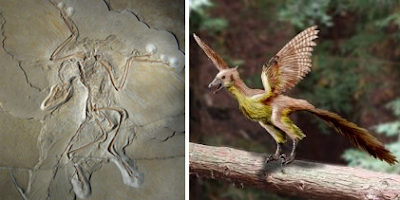On pages 35–47 of WEIT, Coyne talks about the evolution of tetrapods and birds. Tiktaalik roseae is a great example of a "fishapod": it has scales, gills and fins like a fish, but ribs, lungs, and a neck like a tetrapod. It also has ears and wrist and finger bones that are intermediate between fish and tetrapods. Below is Tiktaalik along with some similar creatures, most of which represent other parts of the "out of the water" evolutionary phase.

How did these traits come about? Being able to temporarily crawl up on land conferred a massive advantage to creatures like Tiktaalik because it helped them escape from predators. They used their fin-limbs to push themselves up onto land, and their lungs and ribs allowed them to breathe air. Coyne also points out that the position of their nostrils and eyes at the top of the head would have allowed them to both look and breathe just above the water's surface.
Next up is Archaeopteryx, a feathered dinosaur-like creature that is a close relative of the common ancestor of all birds. Oddly enough, creationists try to claim it's fully bird – probably because at first glance it looks like a bird (see fossil and reconstruction below). However, in fact it has far more reptilian traits (e.g. teeth, claws, 6 vertebrae, a bony tail) than avian ones (e.g. feathers, opposable big toe). On page 41 Coyne has a great illustration demonstrating Archeopteryx's similarity to both the dinosaur Compsothagnus and a modern chicken. Coyne also mentions Mei long, a dinosaur fossilized in a "roosting" position with its head under its wing-like arm, showing that birds and dinosaurs are linked in behavior as well as form.

Coyne also answers creationist questions about how wings evolved ("what good is half a wing?"). Scientists have proposed that feathers may have evolved from reptilian scales as a form of insulation. From there, the ability to glide evolved before the ability to fly. Two major models have been proposed. Under the "trees down" model, theropod dinosaurs (which likely lived partially in trees) used gliding to cushion falls, escape predators or catch prey. Under the "ground up" model, they used their wings to get off the ground for short distances or to help scale steep uphill slopes.
These two groups of examples barely scratch the surface of the fossil evidence for evolution. I'll summarize more of the evidence Coyne presents in later posts.
No comments:
Post a Comment